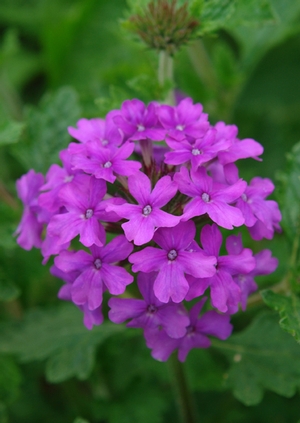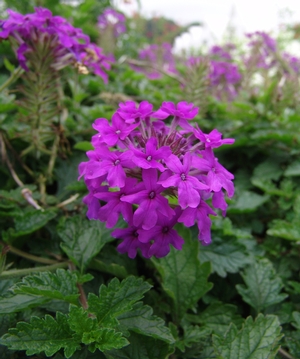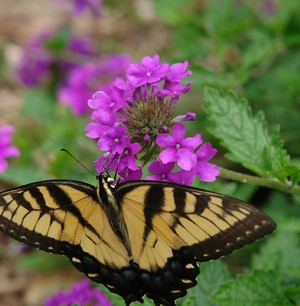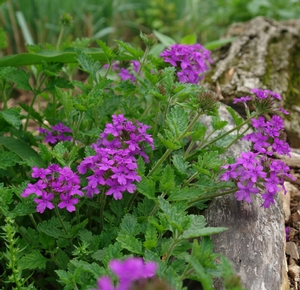Verbena 'Homestead Purple'
Common: verbenaVerbena 'Homestead Purple' - 72 per flat
- Height: 10"-12"
- Spread: 18"
- Spacing: 12"-15"
- Hardiness Zone(s): 7-10


Verbena 'Homestead Purple' - 72 per flat



Named by Dr. Alan Armitage, of the University of Georgia. Vigorously spreading, deep purple clusters from June to November. Excellent clean, deep green foliage with a trailing habit. Has been surviving the winter here lately, but it gets a very slow start in the spring. Best treated as an annual zone 6 or less.
V. canadensis can be found in Pennsylvania to Illinois and Colorado south to Texas and Florida. Prefers moist to dry, well-drained soils in partial shade, but can tolerate drier soils. Propagate by seed or cuttings. Best used as a groundcover or in rock gardens.
"Perennials have captured the hearts of gardeners throughout the nation. Hundreds of new plants have appeared in our gardens in the last decade, including Homestead Purple verbena. It's such an outstanding plant that it was selected as an Arkansas Select plant for 2001.
Since its introduction in the early 1990s, Homestead Purple has sparked widespread interest in all things verbena and has spurred the introduction of over 40 new hardy types.
This rampant perennial grows to 3-feet wide and a foot tall and is topped with a mass of bright purple blooms that start in the spring and continue until frost. Its leaves are deep green, scalloped, coarse-textured and up to 4 inches long.
The plant's stem trails across the ground and turns up at the tips. Flowers are borne in finger-like spikes that are held above the foliage. The flowers grow to 3 inches long and are crowded with individual five-petaled, trumpet-shaped florets.
Homestead Purple is listed as a cultivar of Verbena canadensis, which grows wild throughout the southeast, including all of Arkansas, and ranges as far north as Zone 5 in Iowa. The species is a perennial, but a temperamental one that is very particular about its exposure and drainage, especially during the winter.
In all probability, Homestead Purple is a chance hybrid with another verbena species because its identifying characteristics and vigor are not characteristic of the straight species.
The discovery of the plant is due to the keen eyes of two University of Georgia horticulture professors, Alan Armitage and Mike Dirr. Armitage is one of the nation's foremost authorities on perennial plants, while Dirr is the undisputed woody plant guru.
The two were returning to Athens, Ga., when they drove past a purple mass of flowers neither recognized. They did a U-turn and asked the lady who lived on the homestead about the plant. She didn't know much about it apparently it had been growing there for years. They collected cuttings and the plant went on to fame and glory.
Since 1998, the University of Arkansas and the greenhouse and nursery industry, now combined into the Arkansas Green Industries Association, have met and selected plants to designate as Arkansas Select plants. The criteria for selection are that the plant be relatively new, that it be adapted throughout the state, and that it be easy to grow. Homestead Purple meets
these criteria admirably.
Purple is a color that may scare some gardeners, but the vivid rich purple of Homestead Purple combines well with most other colors. It's an especially good foil for pastel-colored flowers when it's used at the front of the border or in a rock garden.
Homestead Purple should be placed in full sun in a well drained soil. Like most fast growing perennials, it responds well to good soil preparation and occasional fertilization.
This past winter, gardeners in the northern part of the state did lose the plant, probably as much due to wet soil during the winter as the cold. But it should overwinter successfully nine out of 10 Arkansas winters.
Homestead Purple is such a rampant grower that it will quickly fill in any open space. Occasionally it will have a small amount of insect damage on its leaves, but its impressive growth rate and abundant flower production quickly hides any signs of injury." - Gerald Klingaman, retired Extension Horticulturist - Ornamentals, University of Arkansas, 2001